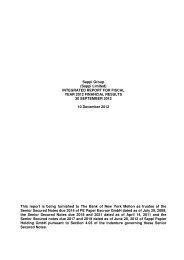2007 Annual Report - Sappi
2007 Annual Report - Sappi
2007 Annual Report - Sappi
Create successful ePaper yourself
Turn your PDF publications into a flip-book with our unique Google optimized e-Paper software.
Notes to the group annual financial statements continued<br />
for the year ended September <strong>2007</strong><br />
2. Accounting policies continued<br />
2.3.11 Provisions<br />
Provisions are recognised when the group has a present legal<br />
or constructive obligation as a result of a past event, in respect<br />
of which it is probable that an outflow of economic benefits will<br />
occur and a reliable estimate can be made of the amount of<br />
the obligation. Where the effect of discounting (time value) is<br />
material, provisions are discounted and the discount rate used<br />
is a pre-tax rate that reflects current market assessments of the<br />
time value of money and, where appropriate, the risks specific<br />
to the liability.<br />
The following specific policies are applied:<br />
• A provision for onerous contracts is recognised when the<br />
expected benefits to be derived by the group from a contract<br />
are lower than the unavoidable cost of meeting the<br />
obligations under the contract.<br />
• A provision for restructuring is recognised only if the group has<br />
created a detailed formal plan and raised a valid expectation,<br />
among those parties directly affected, that the plan will be<br />
carried out, either by having begun implementation or by<br />
publicly announcing the plan’s main features. Future operating<br />
costs or losses are not provided for.<br />
2.3.12 Pension plans and other<br />
post-retirement benefits<br />
(i) Post-employment benefits – pensions<br />
Defined-benefit and defined-contribution plans have been<br />
established for eligible employees of the group, with the assets<br />
held in separate trustee-administered funds.<br />
The projected unit credit method is used in determining the<br />
present value of the defined-benefit obligation and related<br />
current service cost. The current service cost in respect of<br />
defined-benefit plans is recognised as an expense in profit or<br />
loss in the current period.<br />
The projected unit credit method is defined as an actuarial<br />
valuation method that sees each period of service as giving rise<br />
to an additional unit of benefit entitlement and measures each<br />
unit separately to build up the final obligation. The current<br />
service cost is defined as the increase in the present value of the<br />
defined-benefit obligation resulting from employee service in the<br />
current period.<br />
The group’s policy is to recognise actuarial gains and losses,<br />
which can arise from differences between expected and actual<br />
outcomes or changes in actuarial assumptions, these are<br />
recognised immediately in the consolidated statement of<br />
recognised income and expense. Any increase in the present<br />
value of plan liabilities expected to arise from employee service<br />
during the period is charged to operating profit. The expected<br />
return on plan assets and the expected increase during the<br />
period in the present value of plan liabilities are included in<br />
investment income and interest expense.<br />
Gains or losses on the curtailment or settlement of a definedbenefit<br />
plan are recognised in the income statement when<br />
the group is demonstrably committed to the curtailment or<br />
settlement. Past service costs are recognised immediately to<br />
the extent that the benefits are already vested, and otherwise<br />
are amortised on a straight-line basis over the vesting period<br />
of those benefits.<br />
The effects of plan amendments in respect of retired employees<br />
in defined-benefit plans are measured at the present value of<br />
the effect of the amendments and are recognised as an<br />
expense or income in profit or loss for the peiod. The amount<br />
recognised in the balance sheet represents the present value of<br />
the defined-benefit obligation adjusted for unrecognised past<br />
service costs, reduced by the fair value of the plan assets.<br />
Where the calculation results in a benefit to the group, the<br />
recognised asset is limited to the net total of past service costs<br />
and the present value of any future refunds from the plan or<br />
reductions in future contributions to the plan.<br />
Contributions in respect of defined-contribution plans are<br />
recognised as an expense in profit or loss as incurred.<br />
(ii) Post-employment benefits – medical<br />
The projected unit credit method is used in determining the<br />
present value of post-employment medical benefits. The<br />
estimated cost of retiree health care and life insurance benefit<br />
plans is accrued during the participants’ actual service periods<br />
up to the dates they become eligible for full benefits. Experience<br />
adjustments and plan amendments in respect of existing<br />
employees are treated in a similar manner as described in the<br />
preceding paragraph, in the statement of recognised income<br />
and expenditure.<br />
(iii) Workmen’s compensation insurance<br />
<strong>Sappi</strong> Fine Paper North America has a combination of selfinsured<br />
and insured workers’ compensation programmes. The<br />
self-insurance claim liability for workers’ compensation is based<br />
on claims reported and actuarial estimates of adverse<br />
developments and claims incurred but not reported.<br />
82<br />
sappi limited | 07 | annual report
















